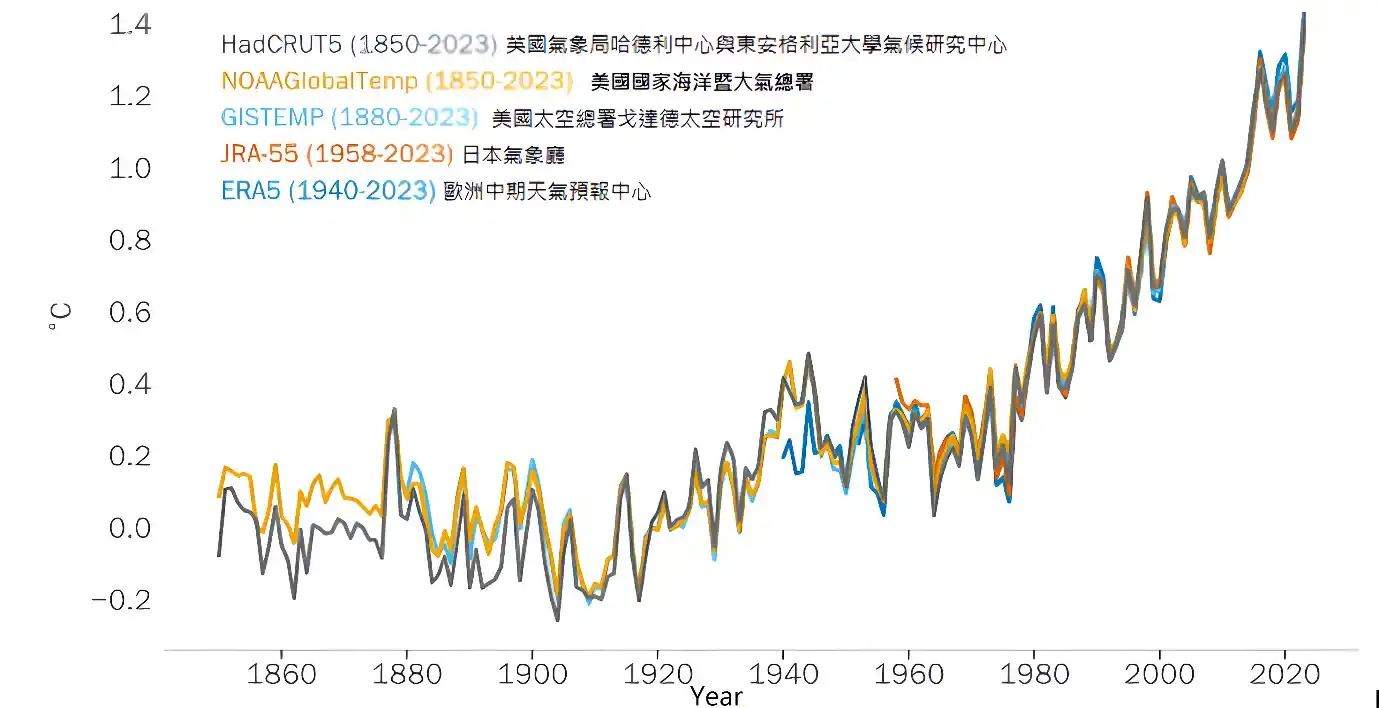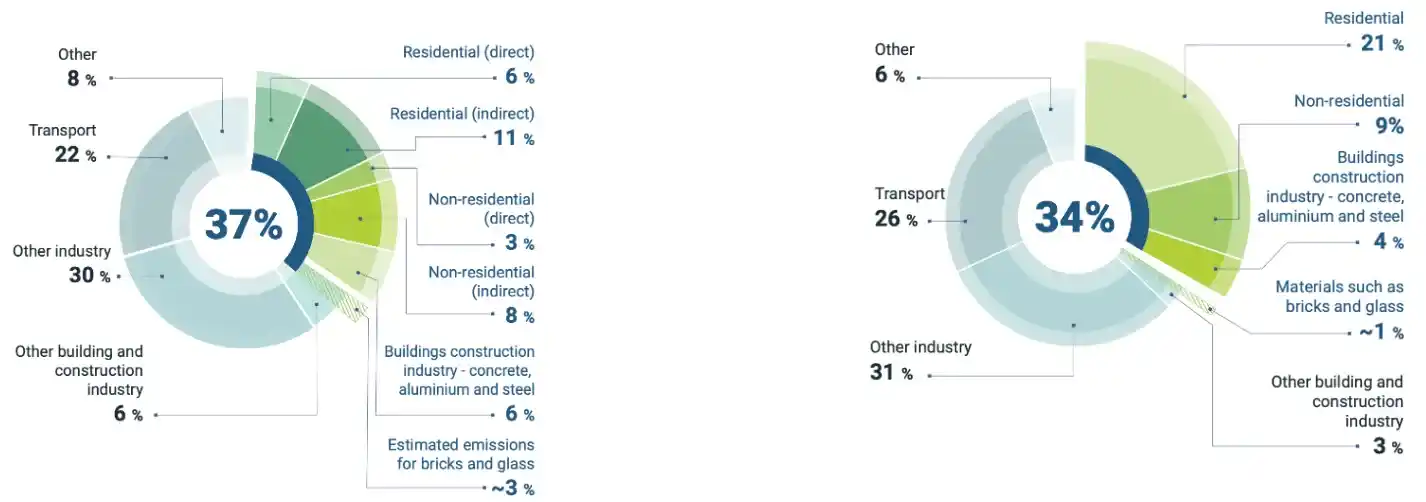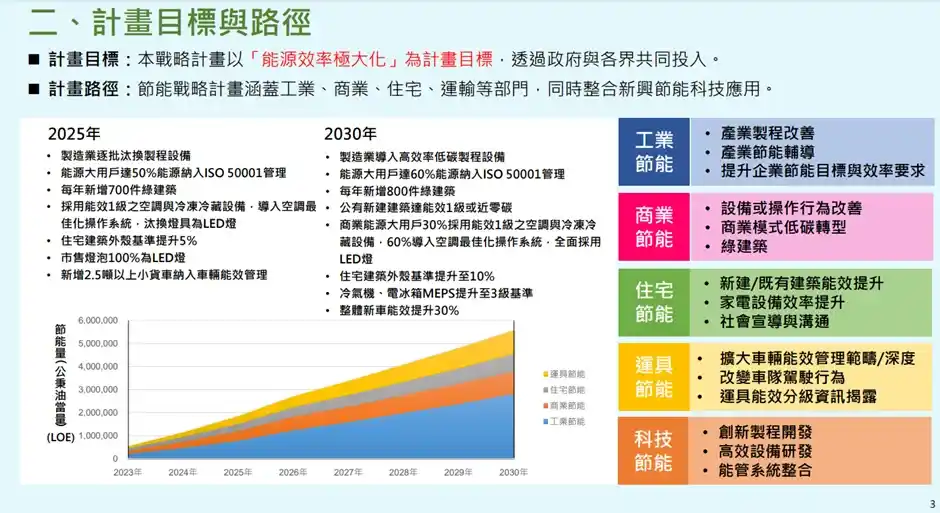Authors: Huang Weiren, Research Assistant and Lin Yunxiang, Adjunct Research Assistant
At the Conference of Parties (COP)21 conference in 2015, the Paris Agreement was signed to curb global warming. Its goal was to ensure that the global average temperature does not exceed 2 °C above pre-industrial levels and to strive to limit it to 1.5 °C. However, according to the Provisional State of the Global Climate 2023 released by the World Meteorological Organization, the global average near-surface temperature as of October 2023 has increased by approximately 1.4 °C compared with the average temperature increase during 1850–1900 (Fig. 1). Based on the data available up to October 2023, it is almost certain that 2023 must have been the hottest year on record.
Against this backdrop, COP28 will be the first formal review of the nationally determined contribution goals, plans, and progress of countries in recent years since the Paris Agreement, which amounts to a comprehensive review of the recent carbon reduction achievements of countries, and it will encourage countries to make more proactive commitments and actions.

Fig. 1 Global Average Temperature Difference (Compared with the average temperature during 1850–1900)
Source of information:(World meteorological organization,2023)
Importance of Net Zero Buildings
According to a research report from the United Nations Environment Programme published in 2022, the construction and building industry accounts for a staggering 37% of global greenhouse gas emissions and represents 34% of global energy demand (Fig. 2). This highlights the urgent need to reduce carbon emissions in the building industry. By comparison, the global energy sector has made significant breakthroughs in recent years, owing to clear development goals and substantial investments, particularly in renewable energy sources, such as solar and wind power, which have witnessed significant annual growth in both generation capacity and technological innovation. Contrastingly, efforts to decarbonize the building sector have focused mainly on new construction and public buildings, where integrating advanced energy-saving technologies and green building principles is easier. However, retrofitting and decarbonizing existing and old buildings has not received sufficient attention in most countries' policies and investment plans.
Therefore, this study first focused on the discussions at the COP28 conference regarding decarbonization in the building sector. The approaches and policies adopted by various countries worldwide to achieve net zero buildings were then reviewed. Finally, the status and preparedness of Taiwan for net zero building policies was examined, with an aim to provide substantive and beneficial insights for Taiwan's future net zero building actions.

Fig. 2 Left: Global CO2 Emissions from Buildings, Construction Operations, and Processes in 2021, Right: Global Final Energy Demand for Buildings and Construction in 2021
Discussions on Decarbonization in the Building Sector at COP28
The thematic discussions at the COP on December 6, 2023, highlighted the importance of the building sector in controlling CO2 emissions, which accounts for nearly 40% of global energy-related CO2 emissions. To address this challenge, a series of significant initiatives were proposed during the meeting, including the Cement and Concrete Breakthrough and the Buildings Breakthrough.
The Cement and Concrete Breakthrough initiative is co-led by Canada and the United Arab Emirates with the primary goal of decarbonizing the cement and concrete industry. In addition to promoting low-carbon or even zero-carbon cement as the preferred choice in future markets, the initiative highlights that cement is a significant source of global industrial CO2 emissions, accounting for 26% of global industrial sector emissions in 2019. Additionally, the cement industry is one of the first regulated industries to be considered for the future implementation of the EU's Carbon Border Adjustment Mechanism. For Taiwan's cement industry, this is not only a challenge for industrial upgrading, but also a significant opportunity.
Buildings Breakthrough is co-led by France and Morocco, with coordination supported by the UNEP. It acknowledges the mutual impact of the development of the building industry with the cultures, economies, environments, and societies of different countries, and emphasizes the importance of the direction of investment in the building industry. Its main objective is to strengthen international collaboration to achieve decarbonization goals in the building sector. This includes not only the design and construction of new buildings but also improvements and renovations of existing buildings. To date, 27 countries have joined the initiative, including China, the United States, Germany, and Japan.
In addition to the ongoing pursuit of innovative building technologies and low-carbon sustainable building materials, COP28 conference also started incorporating carbon reduction considerations into other aspects of the building sector. This includes accelerating the implementation of 15-min city planning, integrating transportation and mobility, improving residential energy efficiency, and facilitating a just transition for energy-poor residents. These measures aim to strengthen the progress of decarbonization in the building sector.
International Building Decarbonization Goals
The following will provide an initial examination of the building sector's net zero related policies and goals in four countries: the European Union, the United States, Singapore, and China. The European Union has presented stage goals and policies on climate change, including a 2030 climate goal to reduce greenhouse gas emissions by 55% compared with the 1990 levels. There is a particular focus on the building sector, with plans to renovate and green 35 million buildings by 2030.
The U.S. federal government has also introduced the EPA's Energy Star Building Program and the U.S. Department of Energy's Net Zero Energy Commercial Building Initiative, which require new commercial buildings to achieve zero energy consumption standards by 2030, with the remaining 50% of commercial buildings expected to achieve the same goal by 2040, and ultimately comprehensive net zero energy consumption by 2050.
Singapore has proposed the Singapore Green Plan 2030 based on the 2030 80-80-80 Goal, which includes ensuring that 80% of buildings are certified with the BCA Green Mark, ensuring that 80% of the new buildings are designed to be ultra-low energy consumption, and improving the energy efficiency of green buildings by 80%.
Furthermore, China plans to fully implement green building standards for all new buildings from 2025 and aims to increase the use of renewable energy in buildings to 8% by 2030. Additionally, the implementation of solar energy panels on the roofs of new public buildings and factory buildings will be increased to 50% by the same year.
Table 1 Carbon Reduction Policies in the Building Sector of the European Union, the United States, Singapore, and China
| 2030 | 2040 | 2050 | |
| European Union | To reduce emissions by 55% compared with those in 1990, renovate and retrofit 35 million buildings, and achieve an overall energy consumption reduction of 36%–39%. | To enhance electrification, implement solar photovoltaic and renewable energy for district heating, achieve 40% zero-emission buildings, and completely phase out the use of fossil fuels in buildings. | To achieve the century goals of climate change mitigation, carbon neutrality, and net-zero carbon emissions. |
| The United States | All new commercial buildings to reach zero energy consumption standards and reduction standards for fossil fuel use in new buildings and major renovations, and to achieve carbon neutrality by 2030. | All commercial buildings to achieve zero energy consumption standards, and to phase out and prohibit the use, installation, and updates of relevant fossil fuel equipment. | All buildings to meet net-zero energy consumption and zero emissions requirements. |
| Singapore | 80% of buildings to meet the BCA Green Mark certification, 80% of new buildings to be designed for ultra-low energy consumption, and green buildings to improve energy efficiency by 80%. | Unclear | To achieve the long-term net zero emissions goal. |
| China |
Starting from 2025, new buildings should fully comply with the green building standards. To increase the use of renewable energy in buildings to 8%, and to increase the implementation of solar energy panels on the roofs of new public buildings and factory buildings to 50% by 2030. |
Unclear | To achieve carbon neutrality by 2060. |
Source of information: Compiled by the author.
According to a preliminary inventory, countries worldwide are prioritizing improvements in new and public buildings, with only the European Union having a more explicit and large-scale renovation plan for existing buildings. This is because the European Union has observed that only 11% of the existing buildings undergo some level of renovation each year, with fewer of these renovations focusing on energy efficiency innovation. Therefore, the European Commission has decided to present a strategy to trigger a renovation wave for Europe to overcome long-term barriers to the transformation rate of existing buildings, to stimulate digitalization, and to create employment and growth opportunities for the entire renovation supply chain. The goal is to complete the renovation and transformation of 35 million buildings by 2030. By increasing and maintaining the speed and depth of renovation and innovation of European buildings, the European Union aims to achieve its 2050 carbon neutrality goal.
Taiwan's Net Zero Building Policy and Future Challenges
Currently, Taiwan's efforts to reduce carbon emissions in the building sector are scattered across the Net Zero Green Living and Energy Conservation strategies within the 12 key strategies of the National Development Council (Figs. 3 and 4). These include promoting the construction of passive energy-saving buildings, use of energy-saving appliances, storing carbon in building materials, promoting green labels, and improving the energy efficiency of household appliances. However, given that Taiwan currently has more than 9 million housing units (the total number of households), relying on current policies alone is not sufficient to guide the nationwide transition to net zero housing. Therefore, the building sector needs more comprehensive and systematic national policy support to achieve the net zero goal.

Fig. 3 Goals and Pathways of the Twelve Strategic Energy-saving Plans
 Fig. 4 Strategies and Measures to Promote the Twelve Key Strategies for Net Zero Green Living
Fig. 4 Strategies and Measures to Promote the Twelve Key Strategies for Net Zero Green Living
As of the second quarter of 2023, according to statistics from the Ministry of the Interior's Real Estate Information Platform, there are currently 9.12 million housing units in Taiwan that are almost 33 years-old on average. Buildings over 30 years account for as much as 53.3%. Particularly, in Taipei City, the proportion of buildings over 30 years is even higher (72%).
Although the current decarbonization pathway to 2030 does not yet include retrofitting of old buildings, energy-efficient renovation of existing buildings is an important aspect of achieving sustainable urban development. In addition to improving climate adaptation and energy efficiency, retrofitting old buildings also addresses multidimensional issues, such as residential safety. Additionally, as Taiwan is located in a seismically active zone and prone to frequent earthquake disasters, relevant building codes have been continuously strengthened in the context of technological advances and increased safety awareness. For example, after the 1999 Chi-Chi earthquake, the design seismic force coefficient in the Seismic Design Code of Buildings was adjusted from 0.23 to 0.33 g. On January 1, 2006, the code was further revised to include the impact factors of seven fault zones and site categories throughout Taiwan. In other words, due to the relatively high average age of most houses in Taiwan, the construction standards of these old buildings at that time were relatively lax, which may result in weaker seismic and disaster resistance capabilities. The government needs to consider how to improve these old buildings to increase their seismic resistance. Simultaneously, efforts should be made to improve their decarbonization, energy efficiency, and climate adaptation resilience to address increasingly severe climate and environmental risks in the future.
Therefore, we recommend that the government should promptly conduct an inventory of existing buildings and zoning plans, and establish renovation regulations and related budget allocations for different building types and ages. In light of the discussions at COP28, accelerating the development of net-zero cities and decarbonizing future buildings depends on improving existing buildings, in addition to technological advances and material improvements and requirements for new buildings. Moreover, expanding sustainability and just transition considerations and providing support for industry upgrades and transitions is important. All of these aspects should be incorporated into the scope of future decarbonization plans of Taiwan for the building sector to establish a more comprehensive and sustainable decarbonization strategy for the building sector.
- 內政部不動產資訊平台(2023)。房屋稅籍住宅類數量。
- 王明鈞(2018)。〈花蓮地震後 你住的房子是安全嗎?〉。信傳媒。
- 王榮進、鄭政利、陳麒任、呂文弘、徐虎嘯、廖婉茹、李招蓉、陳瑜芳(2019)。〈綠建築與近零能源制度之調合研究〉。內政部建築研究所協同研究報告。
- 國發會(2022a)。〈十二項關鍵戰略-節能關鍵戰略行動計畫(簡報)〉。
- 國發會(2022b)。〈十二項關鍵戰略-淨零綠生活關鍵戰略行動計畫(簡報) 〉。
- 經濟部國際貿易署(2023a)。〈歐盟〉。全球碳規範指引網頁。
- 經濟部國際貿易署(2023b)。〈新加坡〉。全球碳規範指引網頁。
- 經濟部國際貿易署(2023c)。〈中國大陸〉。全球碳規範指引網頁。
- European Commission. (2020). A Renovation Wave for Europe - greening ourbuildings, creating jobs, improving lives.
- Global cement and concrete association (2023).“Canada Launches the Cement & Concrete Breakthrough Initiative at COP28.”
- Global alliance for buildings and construction (2023).“Fostering Collabor ation: Buildings Breakthrough.”
- United nations environment programme (2022).“2022 Global Status Report for Buildings and Construction.”
- World meteorological organization (2023).“Provisional State of the Global limate in 2023.”

This work is licensed under a Creative Commons Attribution-NonCommercial-NoDerivatives 4.0 International License.
※The aforementioned may not be copied for commercial use without the center's consent, thank you.※
